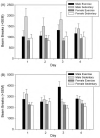Chronic forced exercise during adolescence decreases cocaine conditioned place preference in Lewis rats
- PMID: 20615434
- PMCID: PMC3188407
- DOI: 10.1016/j.bbr.2010.06.033
Chronic forced exercise during adolescence decreases cocaine conditioned place preference in Lewis rats
Abstract
Chronic physical activity (exercise) may be beneficial in the prevention of substance use disorders; however, the extent to which physical activity can interfere with the reinforcing effects of drugs during the adolescent period, which is one of great vulnerability for drug experimentation, has not been fully evaluated. Here, we assess the effects of chronic forced exercise during adolescence on preference for cocaine using the conditioned place preference (CPP) paradigm in male and female Lewis rats. The group of rats exposed to exercise ran on a treadmill for 6 weeks on a progressive time-increased schedule for up to 1h of exercise per day, while the groups of sedentary rats remained in their home cage. Following the 6 weeks of exercise exposure, rats were tested for cocaine CPP. Results showed that chronic exercise significantly attenuated cocaine CPP in both males and females compared to a sedentary environment. Furthermore, male exercise rats failed to show significant cocaine CPP. In contrast, female exercise rats still showed cocaine CPP but it was significantly reduced compared to the female sedentary rats. Females also exhibited greater cocaine CPP than males overall. These findings suggest that strategies to promote physical activity during adolescence may be protective against cocaine abuse in both males and females, and these findings merit further investigation. We also corroborate a gender-specific sensitivity to the reinforcing effects of cocaine, highlighting the need to consider gender-tailored exercise interventions for drug abuse prevention.
Copyright 2010. Published by Elsevier B.V.
Figures





References
-
- Hattori S, Naoi M, Nishino H. Striatal dopamine turnover during treadmill running in the rat: relation to the speed of running. Brain Res Bull. 1994;35(1):41–9. - PubMed
-
- Freed CR, Yamamoto BK. Regional brain dopamine metabolism: a marker for the speed, direction, and posture of moving animals. Science. 1985;229(4708):62–5. - PubMed
-
- Martinez D, Broft A, Foltin RW, Slifstein M, Hwang DR, Huang Y, et al. Cocaine dependence and d2 receptor availability in the functional subdivisions of the striatum: relationship with cocaine-seeking behavior. Neuropsychopharmacology. 2004;29(6):1190–202. - PubMed
-
- Wang GJ, Volkow ND, Thanos PK, Fowler JS. Similarity between obesity and drug addiction as assessed by neurofunctional imaging: a concept review. J Addict Dis. 2004;23(3):39–53. - PubMed
-
- Volkow ND, Fowler JS, Wolf AP, Schlyer D, Shiue CY, Alpert R, et al. Effects of chronic cocaine abuse on postsynaptic dopamine receptors. Am J Psychiatry. 1990;147(6):719–24. - PubMed
Publication types
MeSH terms
Substances
Grants and funding
LinkOut - more resources
Full Text Sources
Miscellaneous

